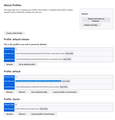
Changing the Firefox profile
I'm setting up Firefox on a new computer. I haven't done this for a while and the interface has changed, so I'm not sure how it works.
I want to move my Firefox profile to a directory in the Documents library to simplify backup. Following the Mozilla instructions I found, I opened about:profiles and clicked the Create New Profile button. I deleted the contents of the directory that Create New Profile created and copied the contents of the default profile directory to it. The last step is to tell Firefox to use my new profile instead of its default.
But the about:profile page lists three profiles: default-release, default, and my new one. The first two have a Set as default profile button; the last does not. So it appears that I can tell Firefox to use the default-release profile or the default profile, but there's no way I can tell it to use my new profile. I can only Launch profile in new browser -- presumably something I'll have to do every time I run Firefox.
This makes no sense. How can I tell Firefox to use my new profile -- not to launch a new browser with it, but to use it, period? If I can't, why can't I? Every version of Firefox I've ever installed up to now allowed this.
Also, the default-release profile section of about:profiles has the note "This is the profile in use and it cannot be deleted." So it appears that Firefox uses the default-release profile instead of the default profile as its default profile. What is the default-release profile? Why isn't the default profile the default profile?
Modified
All Replies (3)
JHS said
But the about:profile page lists three profiles: default-release, default, and my new one. The first two have a Set as default profile button; the last does not. So it appears that I can tell Firefox to use the default-release profile or the default profile, but there's no way I can tell it to use my new profile. I can only Launch profile in new browser -- presumably something I'll have to do every time I run Firefox.
Usually that means it is already your default profile. Any time you use the Create function, Firefox makes the new profile your default. Have you already tried exiting out of Firefox and restarting it to test?
Also, the default-release profile section of about:profiles has the note "This is the profile in use and it cannot be deleted." So it appears that Firefox uses the default-release profile instead of the default profile as its default profile. What is the default-release profile? Why isn't the default profile the default profile?
Starting in Firefox 67, different builds of Firefox (like release and Developer Edition) typically use different folders. I don't know why there is a .default profile, but I wouldn't leave it and not remove it. For historical reference: Dedicated profiles per Firefox installation.
Thank you, I don't understand why that is so but I understand what. I copied the default-release root directory to my custom profile's directory and got what I wanted.
I'm still puzzled by the "root" and "local" directories, though. The two default profiles have both; my custom profile has root only. According to about:profiles, the root directories are under roaming. That explains how they are used, but again, why is a mystery. Why should I want an application to behave differently when I'm roaming than when I'm using it locally? And if there's a reason, and I want a local directory in my custom profile, why doesn't about:profiles have a provision for creating one?
"Roaming" and "Local" isn't about whether you are at home vs. away. I think it was something about Microsoft's attempt to compete with "network computers" back in the day, with the idea that the Roaming folder would live in a data center rather than on your PC. For a home PC, there's really no difference.
Firefox uses the folder under local for cache and other temporary/dispensable files. Maybe this was meant to keep Roaming lighter weight if it had to be used over a network?? Anyway, if Firefox didn't create the Local folder automatically, I guess the "cache2" folder must also be in your root directory?

